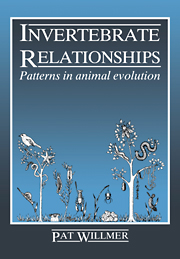Book contents
- Frontmatter
- Contents
- Acknowledgements
- Part I Introduction to animal phylogeny
- Part II Sources of evidence in invertebrate phylogeny
- 3 Evidence from the fossil record
- 4 Evidence from chemistry and genetics
- 5 Evidence from embryology and larvae
- 6 Evidence from cell ultrastructure
- Part III Phylogeny of major groups
- References
- Index
3 - Evidence from the fossil record
Published online by Cambridge University Press: 08 January 2010
- Frontmatter
- Contents
- Acknowledgements
- Part I Introduction to animal phylogeny
- Part II Sources of evidence in invertebrate phylogeny
- 3 Evidence from the fossil record
- 4 Evidence from chemistry and genetics
- 5 Evidence from embryology and larvae
- 6 Evidence from cell ultrastructure
- Part III Phylogeny of major groups
- References
- Index
Summary
Introduction
The fossil record is the most obvious and tangible evidence of the past history of animals, and ideally it should be the final arbiter in deciding between opposing theories on major issues of phylogeny that have been derived from living fauna. This, at least, is the conventional view, and it is only in the last two decades that an increasingly theoretical approach to phylogenetic study has brought into question the role of palaeontology as a superior and ultimate guide to relationships (e.g. Hennig 1965, 1966; Løvtrup 1977; Nelson 1978). Patterson (1981) points out that fossils have almost never been used to overturn phylogenies derived from Recent fauna, and that the widespread belief that fossils are the best way of determining relationships is a myth. Nevertheless, it remains true that a phylogeny that conflicted with the evidence from fossils could not seriously be upheld; so a knowledge of fossil remains is generally regarded as a necessary accompaniment to a sensible appreciation of relationships.
It is a widely repeated view that the invertebrate fossil record is so limited (because their soft bodies are poor material for preservation) that it can tell us nothing of invertebrate evolutionary history. Modern reviews make it very clear that the record available is by no means so inadequate, so we should expect to learn a good deal from an understanding of the preserved remains that are available. A recent quote (Stanley 1979) admirably reflects this more positive view: ‘The role of palaeontology … has been defined narrowly because of a false belief … that the fossil record is woefully incomplete.’
- Type
- Chapter
- Information
- Invertebrate RelationshipsPatterns in Animal Evolution, pp. 52 - 76Publisher: Cambridge University PressPrint publication year: 1990



